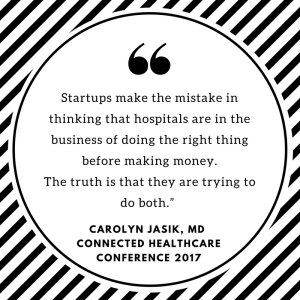The Connected Health Conference in Boston featured a Panel of innovators in the healthcare space. I was happy with the panel selection since I get to talk to a lot of startups in the Health Tech IT space and the members of the panel are well respected and dedicated to innovation. This panel focused on health systems and partners that had investments and invested their time and energy in companies. Organizations that invest in digital healthcare companies have a fundamentally different relationship. Ethical considerations of the for profit arm of a healthcare system can be complicated and this panel represented leaders in balancing business and healthcare.
Rasu Shrestha, MD MBA
Rasu Shrestha, MD MBA headed the panel. As chief innovation officer of UPMC and executive vice president of UPMC Enterprises, he is, he is an expert at evaluating which companies make a significant impact in healthcare from a business perspective while improving outcomes. Innovation is largely a measure of collaborative effort of a system. “What do you think are the ways to encourage and amplify this collaboration that we are talking about? Every hospital and system has a different system for their innovation adoption and UPMC is leading the way with system design. For them, there is a method to the madness. They prioritize design thinking and use agile methodology.
“How do we make sure that we are able to leverage the speedboats in this area?”
Dr. Rasu Shrestha
UPMC has 4 focus areas and has strong identity. One of the key elements of success for an organization is to define objectives- both what they do and what they do not do.
Healthcare incentives should address the overall value of making the right decisions. In a fee for service world there is not an ICD10 code for NOT doing a procedure that a patient doesn’t need. UPMC sees overall system value in not adding unnecessary procedures or tests. This at risk status allows them to move beyond addressing current needs and looking ahead 3-5 years to see what they need to be building to improve health.
Dr. Shrestha challenged healthcare systems to put their money where their values are. If value based healthcare is important to you, then invest in it. If you have “skin in the game” and investment you become co-creators of a solution, so find people you want to work with. There are innovators and entrepreneurs that are coming to you but they carry more risk so it’s no wonder that there is a culture clash.
Best Practice for innovation accounts for culture clashes and misaligned values. At UPMC they are working to co-create the solution- don’t profess to know it all. This attitude of always learning helps uncover innovation that might otherwise be hidden. People need to come in and have a conversation with the healthcare system about the problems and challenges they are trying to solve and how to move that forward. Get clinicians to focus on what problems they want to design then work around them. Dr. Shrestha mentioned that nurses are really innovative and their front line perspective is invaluable to healthcare systems
Eric Halvorsen
Eric Halvorsen work as a director with the Innovation institute and investment fund of Texas medical center- which is the biggest medical center in the country 21 hospitals. Texans should be proud that their innovation institute has been voted most helpful in an informal survey. Speaking of which we should do reviews of the relative helpfulness of innovation funds. I’m confident TMCx would be in the top. In talking to startups about digital health I ask people which incubators and groups are worth being part of. When I asked a friend who had been involved in a few groups who the most helpful was, TMCx was her answer. She said they actually try to pair companies with the people who could use their system and have meaningful connections. She is not the only one who has recommended them.
Eric discussed hospital decision making. Many of the hospitals in the TMC network have opened themselves to startups. Of the 21 companies we had 82 agreements within the 4.5 months of the accelerator by matching companies to hospitals that they need. Every hospital system has a unique decision making process and finding the influencers in that space can be complex. They teach companies that decision making is from the ground up not top down. The CEO doesn’t make most decisions it’s the directors of departments and users that push decision making. Innovative companies need a champion for the product to drive decision making and adoption. This type of training helps startups get better adoption.
In explaining barriers to adoption Eric provided valuable insight about the importance of industry savvy and knowledge. Some investors and innovators don’t want to do the clinical validation or studies because they want to get to their exit faster. Pushing immediate returns can hurt long term ability to sell outcomes to the client you need to do your work. Some people call Digital Health snakeoil- most of the companies are not showing clinical validation of their product- they can’t show you that they have that impact in terms of outcomes.
The volume of companies and decision making is overwhelming- one CEO said he gets more than 600 inbound requests and doesn’t know where to send them. TMCx helps teach innovators where to send those requests and helps the Texas hospital systems it works with know where the best fit will be.
Carolyn Jasik, MD–
Carolyn Jasik is working with Omada Health and has a history from the provider side. Dr. Jasik left the healthcare system innovation center and is now working with a vendor so her perspective challenged both sides. She challenged healthcare systems to be more focused in their support of companies. The invitation that “we need to stop serving on advisory boards and stop having coffee and start getting involved with developing one company” resonated with me. I’ve seen healthcare systems that have meetings to plan meetings. This organizational waste has a negative impact on the system, costing thousands of dollars in wasted time. It can also suffocate startups and smaller players- effectively starving them out in a waiting game with bureaucratic waste.
“Some people try to defend their lack of validation as innovation”
Dr. Carolyn Jasik
The inefficient relationships in the healthcare machine have frustrated many idealists and startups. Every system has a different method of vetting companies and decision making. Carolyn warned that “Startups make the mistake in thinking that hospitals are in the business of doing the right thing before making money and the truth is that they are trying to do both.”
Startups should ask themselves “What is the value proposition you bring to a health center when you are partnering with them?” If you are still in validation you still need to think about investing in developing those relationship. One health system might be the type where you have a validation system but eventually you will have a product that is worth buying. If you get to the point where you’ve validated your product but people aren’t buying then you probably don’t have product market fit. Personally, I’ve heard innovators that were frustrated by a healthcare system that wanted to be paid to run a study or trial. I’ve also spoken with healthcare systems that are frustrated by using their organizational assets to build someone else’s company.
Joe Kvedar, MD
Dr. Joe Kvedar is the VP of connected health at Partners Healthcare. He works to move care delivery from the hospital into the day to day lives of patients. His book, The New Mobile Age: How Technology Will Extend the Healthspan and Optimize the Lifespan launched at the Connected Health Conference.
His expertise gave a great perspective about barriers to adoption. Professionals innovating in the space and developing relationships with organizations over the years at times have struggled with early stage companies. Healthcare is like an ocean liner. To tinker with something you have to do it the right way. In order to do that you need resources and sometimes startups are resource depleted. Healthcare systems feel like they are experts and want to re-test every potential partner. Every hospital you go visit wants to re-test things and wants to feel unique. If we are going to test your things it requires resources and you get into this awkward situation where you say – you have something you want us to pay for but we want you to pay us to test us.
Dr. Kvedar discussed alignment of reimbursement and actions that lead to better health. Being able to reimburse for certain things would change the industry fast- it is an important driver of behavior. Some of the other policy things- like more policy around tort reform or around educating people to be more accountable for their own health outcomes would be important to improve health.
“We’ve had to educate people that a 10 person focus groups is not a clinical trial”
-Dr. Joe Kvedar
Lesley Solomon-
Lesley Solomon ran the Brighams innovation hub where they did digital health for many years and came to an organization where they weren’t as advanced in digital health. 3 months ago she transitioned to the Dana-Farber Cancer Institute as the SVP of innovation and Chief Innovation Officer. This transition had helped her be part of the process to develop a strategy. She mentioned that there are ways to mesh solutions with problems more efficiently than we are doing it now. Awareness of where an organization is at helps innovators and healthcare systems work together more efficiently. Startups should know which type of system they approach and which they prefer to work with.
The early stage at Dana Barber meant they are starting to define what the digital health initiative is going to be for the entire organization. To begin this process they discussed what the challenges are that they are faced with so they can really think about which startups can help solve those problems.
Creating an organized innovation system also involves a high tolerance of chaos. There is so much chaos and so many startups reaching out so it was important to identify what key challenges are. Once those challenges have been defined think about how a company can meet those challenges with the right companies. Matching which people to work with to solve problems can mean partnership with a startups or seasoned company. “It doesn’t have to be a startup but we can find a company that can help us solve those problems. We want to focus and be able to accomplish a few really good things in the first two years and then make a broad program.”
Moving Beyond the Panel
Effective collaboration means a high tolerance for chaos and a highly organized system. Defining your role as an organization and problems you want to help solve or want help with is the center of improvement. Healthcare systems need to invest in aligning their investment innovation strategy with well defined goals. Often this investment is time. The time to promote a company or work with them, or the time to teach and mentor others, or the time to listen to the people who will use what you have to offer. Leaders who put the time and resources into this long term strategy will build a sustainable long term business. They will also see better returns on long term health outcomes. Harnessing the speedboats through investment, whether financial or human capital, will create winning collaborations.
Article was updated to reflect the position of Dr. Rasu Shrestha


